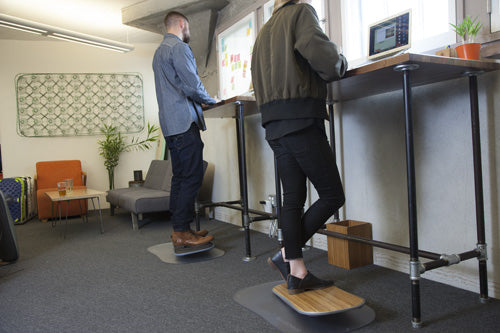4 Simple Tips to Make Transitioning to a Standing Desk Setup Easier

Spending more time standing up is one of the easiest ways in which you can add more movement into your life.
And when you constantly move more, you start feeling more focused, relaxed, and overall happier while getting work done.
It's the reason why so many people fall in love with their standing desks.
However, it’s important to understand that there will be an adaptation period while your body gets used to standing up for longer periods of time.
What happens in the first few days of using a standing desk?
Think of moving to a standing desk setup like starting a new workout.
And just like any new workout routine, the first days can be tough.
You might feel sore in unexpected places and a little more tired than usual.
If you workout later in the day, your workouts may suffer a bit.
Don’t worry, this is normal. We all go through this adaptation phase. Especially if you’ve been using a regular desk for most of your life.
4 tips to make your standing desk transition easier
Everyone’s experience with transitioning to a standing desk is different. We all have different backgrounds and use our workspace in different ways.
For example, your experience will be different if the majority of your time is spent typing compared to someone who spends most of their time using mouse based tasks.
Here are 4 tips that will help you transition to a standing desk.
1. Gradually increase how much time you spend standing.
This is the most common mistake that new standing desk users make. They want to start using their shiny new standing desk all day, just like they did their regular sitting desk.
And for most, this is the wrong approach since they end up feeling beat down and exhausted.
Our recommendation is to ease into it.
Gradually spend more time standing until you can spend an entire morning or afternoon comfortably.
Remember that there’s no rush. Give your body time to adapt and the whole experience will be much more enjoyable.
2. Set the right monitor and keyboard height.
A standing desk won’t be of much help if you’re hunched over your monitor and keyboard. So making sure your monitor and keyboard are at the right height is key to making sure your setup is ergonomically sound.
Here are a few guidelines you can follow:
- Your eyes should be approximately 2-3 inches below the top of the monitor.
- The monitor must be an arm’s length away (at least).
- Keep your elbows bent at a 90-degree angle for an ideal keyboard height.
Your neck and shoulders should feel relaxed.
The standing desk should be the one adjusting to your body and not the other way around.
Realized that you need a monitor riser? We’ve got you covered.
3. Shift your body and move in every direction.
If you’ve been tethered to a regular desk for your entire life, your body essentially forgot how to feel comfortable while standing.
This is why during the first couple of weeks you may feel stiff or rigid while using your workspace.
This is normal and will go away when your body re-learns how to spend time standing.
One of the easiest ways to help in this process is to add both intentional and effortless movement.
For example you could add some desk yoga (check out this article) if you want to do some intentional movement.
Or you could try a balance board if you want to move more in place without having to think too much about it.
4. Spend time barefoot, try different shoes, and consider an anti-fatigue mat.
Your feet muscles are the first ones that need to get used to all the extra work from the increased time standing.
If at home, you can try spending more time barefoot while standing. Being barefoot is a great way to allow your feet to naturally strengthen and get used to spending more time standing.
A different pair of shoes might also be a good alternative. There’s no one size fits all when it comes to shoe design. Some people feel great with cushioned shoes and some others prefer a more minimalist feel to them.
Experiment to find what works best for you.
And you can also consider adding an anti-fatigue mat to your desk setup. These mats will help cushion the floor and allow a small shift on your feet. The result is that you feel less tired and fatigued at the end of the day.
Standing is a great way to feel better
In our modern lives, we tend to spend way too much time sitting down. Even to the point where sitting for extended periods of time is starting to be considered a health hazard.
The good news is that by transitioning to a standing desk you’ll be making a long term investment in your health and wellbeing.
And as an added bonus, you’ll find it easier to focus and be more productive.
In other words, your workspace will help you flow better throughout your day.


Leave a comment